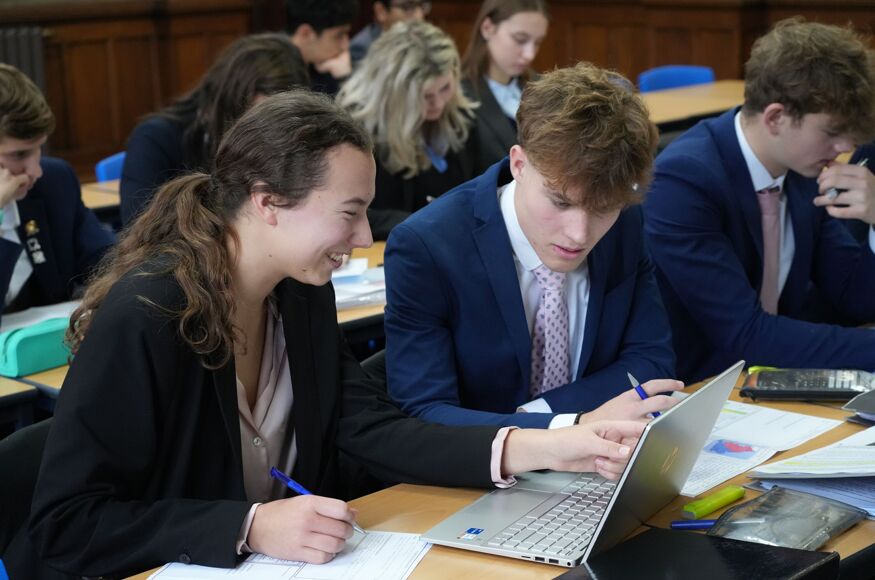
- Home
- News and Events
- Teaching and Learning Blogs
- 'Waving Goodbye to "Revise More...&...
'Waving Goodbye to "Revise More..."'

In the Autumn of 2023, the Chemistry Department decided to focus on the quality of pupil reflection and target setting following assessments. We identified that this was often lacking in direction, detail and usefulness. High-ability pupils usually had the reflective skills required to thoroughly analyse their performance; however, medium and lower-ability pupils, who most needed to make progress, did not have these same skills. As Gwynfor explains:
“Reflection sheets really highlighted the difference in pupils' ability to engage with self-reflection, with lower ability students needing significantly more scaffolding to be able to identify effective targets for improvement”
Gwynfor
'Using a scaffolded sheet, pupils reflect on their performance in four areas'
Rationale
We aimed to consider the thinking we hoped our pupils would undergo as part of this reflective process and explore how we could facilitate this. We wanted to support them in developing their skills of reflection and target setting, empowering them to take more ownership of their progress over time. It was time to revamp how we wanted DIRT to be structured and consider how to enable pupils to produce the most meaningful work during DIRT and beyond.
Following trials of many different structured DIRT sheets and processes, here is how we currently aim for the process to work for our pupils. Steps 1 – 5 are fully embedded and step 6 is what we are currently working on:
STEP 1
Pupils make corrections to their test using a mark scheme, asking the teacher questions if needed. The teacher will also give group feedback on particular areas as needed.
STEP 2
Using a scaffolded sheet, pupils reflect on their performance in four areas:
- Preparation (revision techniques and revision session length and frequency)
- Exam techniques used
- Reasons for marks lost
-
Specific subtopics to work on
Pupils complete ‘now' target tasks for homework, and upload evidence of completion
STEP 3
Pupils identify areas for improvement ahead of the next test and set appropriate ‘future' targets (usually relating to revision, exam technique or attending clinics).
STEP 4
Pupils identify what can be improved there and then, often relating to key knowledge or calculations. Staff set appropriate ‘now' targets, based on the assessments, with linked tasks.
STEP 5
Pupils complete ‘now' target tasks for homework, and upload evidence of completion
STEP 6
Teachers give feedback on this work, including the DIRT sheets, targets and evidence of completion of their ‘now’ targets. Prior to the next test, pupils refer back to their future targets to implement as necessary.
Rome wasn’t built in a day, and we began with a humble DIRT sheet with a few open-ended questions for them to answer. Over a year and a half, we have tweaked and improved the sheet over time, making a high number of additions, removals and amendments. This has been a collaborative process with all members of the department trialling different versions of the sheets for both IGCSE and A Level students, giving feedback and making suggestions. We have also taken pupil feedback into account. Members of the team have enjoyed the process of reflecting on this area of T&L as a team, as Ben and David explain:
“It has been really interesting and useful to reflect on our DIRT sheets together as a department and see them grow and develop through fruitful discussion. They have supported teacher feedback and report writing and also offered a much deeper insight into how our students learn outside the classroom and prepare for assessments.”
Ben
"I have really enjoyed the process of reviewing and refining the DIRT sheets over time. It is helpful to see it as a working document and I am sure we will continue to refine it further to allow the students to get more out of it."
David
What have we learnt over time?
- Pupils benefit from tick lists of revision techniques and exam techniques as part of DIRT, as they enable them to quickly reflect upon their revision strategies and also provide a list of suggestions of what to try next time, e.g. “Next time I am preparing for a test, I will include blurting”. For teachers, these DIRT tick lists allow us to see if they are missing anything important, such as including a memorisation technique.
- Detailed, scaffolded DIRT sheets have been immensely beneficial for both pupils and teachers. These structured tools allow pupils to engage in meaningful self-reflection at their own pace, with clear, step-by-step guidance. Simultaneously, they provide teachers with valuable insights into students' challenges and achievements, enabling more targeted support.
- Allocating homework time for pupils to complete and upload their ‘now' target tasks (and marking it) incentivises students to reflect more deeply and take the process more seriously. Where teachers give constructive comments on how pupils have reflected, we have seen an improvement in their approach to future DIRT. As pupils get used to the process, the quality of the DIRT improves and less feedback is needed.
- Pupils require significant guidance in how to set appropriate targets, beyond the use of ‘SMART’. Asking pupils to differentiate between targets for the future and targets they could act upon now has made active DIRT more manageable, as Heledd and Deepika explain
Providing students with two types of targets allows them to think about their understanding
“Providing students with two types of targets allows them to think about their understanding and recall of content now, as well as reflecting on their revision and exam technique for the future. With guidance, they can show improvement in the short term by giving themselves ‘now’ target tasks, such as further exam questions or using flashcards; whereas, ‘future’ targets allow students to trial various revision and exam techniques moving forwards. As a result, I've seen that students are more reflective and set themselves more achievable targets.”
Heledd
“This year I have been focussing on what students write on their DIRT worksheets; guiding students to link their weaknesses to the target they set has been an area for improvement. Reading students' DIRT while they are setting targets and having conversations with them about their reflections has been mind-blowing.
Deepika
Conclusions
Over the past year and a half, our journey to improve the quality of pupil reflection, target setting and meaningful corrections has been one of continuous refinement and collaboration. By structuring the DIRT process more effectively, the impact has been clear - students are becoming more reflective, more proactive, and more capable of identifying and addressing their own learning gaps and how to make progress. Meaningful reflection takes time to cultivate, but we have made great progress, and we gladly wave goodbye to the days of pupils setting targets like “revise more’’.



